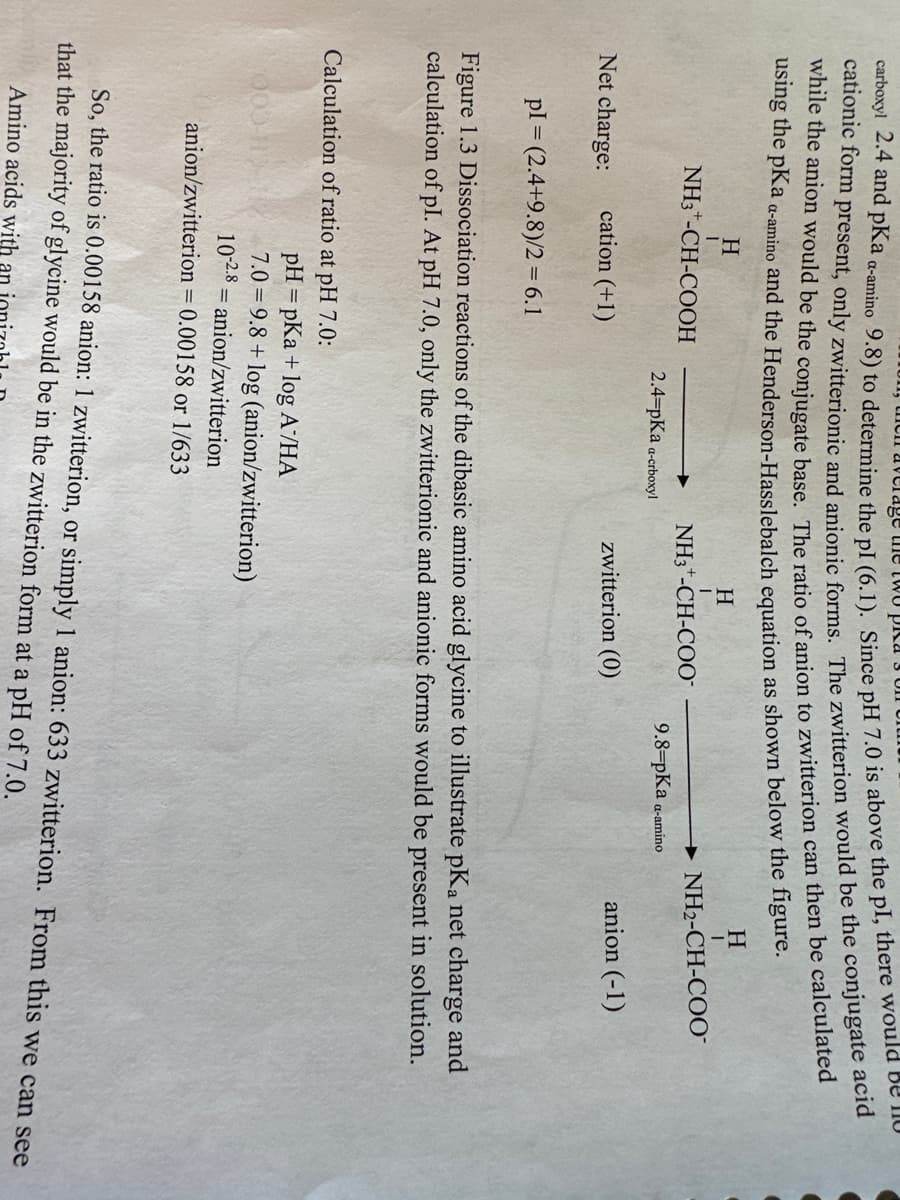sing Figure 1.3 of the Introduction as an example, a) draw all the structures of the tribasic amino acid lysine involved in the equilibrium reactions that would take place during titration against NaOH, starting with the fully protonated form below (draw the R-group in full). HAN+-CH- COOH (CH2)4 NH°+ b) indicate the numerical pa value of each equilibrium reaction, and which ionizable group is being dissociated in each step. c) indicate the net charge of the amino acid at each step and identify the zwitterion. d) Calculate the pI of this amino acid (show the calculation). e) What would be the predominant ionization states of this amino acid at physiological pH (7.4) and at this pH, what would the ratio of these two states be (show the calculation)?
sing Figure 1.3 of the Introduction as an example, a) draw all the structures of the tribasic amino acid lysine involved in the equilibrium reactions that would take place during titration against NaOH, starting with the fully protonated form below (draw the R-group in full). HAN+-CH- COOH (CH2)4 NH°+ b) indicate the numerical pa value of each equilibrium reaction, and which ionizable group is being dissociated in each step. c) indicate the net charge of the amino acid at each step and identify the zwitterion. d) Calculate the pI of this amino acid (show the calculation). e) What would be the predominant ionization states of this amino acid at physiological pH (7.4) and at this pH, what would the ratio of these two states be (show the calculation)?
Biochemistry
9th Edition
ISBN:9781319114671
Author:Lubert Stryer, Jeremy M. Berg, John L. Tymoczko, Gregory J. Gatto Jr.
Publisher:Lubert Stryer, Jeremy M. Berg, John L. Tymoczko, Gregory J. Gatto Jr.
Chapter1: Biochemistry: An Evolving Science
Section: Chapter Questions
Problem 1P
Related questions
Question
100%
Using Figure 1.3 of the Introduction as an example,
a) draw all the structures of the tribasic amino acid lysine involved in the equilibrium reactions that would take place during titration against NaOH, starting with the fully protonated form below (draw the R-group in full).
HAN+-CH- COOH
(CH2)4
NH°+
b) indicate the numerical pa value of each equilibrium reaction, and which ionizable group is being dissociated in each step.
c) indicate the net charge of the amino acid at each step and identify the zwitterion.
d) Calculate the pI of this amino acid (show the calculation).
e) What would be the predominant ionization states of this amino acid at physiological pH
(7.4) and at this pH, what would the ratio of these two states be (show the calculation)?

Transcribed Image Text:en average the two pra s
carboxyl 2.4 and pKa a-amino 9.8) to determine the pI (6.1). Since pH 7.0 is above the pl, there would be no
cationic form present, only zwitterionic and anionic forms. The zwitterion would be the conjugate acid
while the anion would be the conjugate base. The ratio of anion to zwitterion can then be calculated
using the pKa a-amino and the Henderson-Hasslebalch equation as shown below the figure.
H
H
I
I
NH2-CH-COO™
NH3 -CH-COOH
Net charge:
cation (+1)
2.4=pKa a-crboxyl
Calculation of ratio at pH 7.0:
H
I
NH3-CH-COO™
zwitterion (0)
9.8=pKa a-amino
pl= (2.4+9.8)/2 = 6.1
Figure 1.3 Dissociation reactions of the dibasic amino acid glycine to illustrate pKa net charge and
calculation of pl. At pH 7.0, only the zwitterionic and anionic forms would be present in solution.
pH =pKa + log A/HA
7.0 9.8+ log (anion/zwitterion)
10-2.8
anion/zwitterion
anion/zwitterion = 0.00158 or 1/633
anion (-1)
So, the ratio is 0.00158 anion: 1 zwitterion, or simply 1 anion: 633 zwitterion. From this we can see
that the majority of glycine would be in the zwitterion form at a pH of 7.0.
Amino acids with an
Expert Solution
This question has been solved!
Explore an expertly crafted, step-by-step solution for a thorough understanding of key concepts.
This is a popular solution!
Trending now
This is a popular solution!
Step by step
Solved in 2 steps with 1 images

Recommended textbooks for you

Biochemistry
Biochemistry
ISBN:
9781319114671
Author:
Lubert Stryer, Jeremy M. Berg, John L. Tymoczko, Gregory J. Gatto Jr.
Publisher:
W. H. Freeman

Lehninger Principles of Biochemistry
Biochemistry
ISBN:
9781464126116
Author:
David L. Nelson, Michael M. Cox
Publisher:
W. H. Freeman

Fundamentals of Biochemistry: Life at the Molecul…
Biochemistry
ISBN:
9781118918401
Author:
Donald Voet, Judith G. Voet, Charlotte W. Pratt
Publisher:
WILEY

Biochemistry
Biochemistry
ISBN:
9781319114671
Author:
Lubert Stryer, Jeremy M. Berg, John L. Tymoczko, Gregory J. Gatto Jr.
Publisher:
W. H. Freeman

Lehninger Principles of Biochemistry
Biochemistry
ISBN:
9781464126116
Author:
David L. Nelson, Michael M. Cox
Publisher:
W. H. Freeman

Fundamentals of Biochemistry: Life at the Molecul…
Biochemistry
ISBN:
9781118918401
Author:
Donald Voet, Judith G. Voet, Charlotte W. Pratt
Publisher:
WILEY

Biochemistry
Biochemistry
ISBN:
9781305961135
Author:
Mary K. Campbell, Shawn O. Farrell, Owen M. McDougal
Publisher:
Cengage Learning

Biochemistry
Biochemistry
ISBN:
9781305577206
Author:
Reginald H. Garrett, Charles M. Grisham
Publisher:
Cengage Learning

Fundamentals of General, Organic, and Biological …
Biochemistry
ISBN:
9780134015187
Author:
John E. McMurry, David S. Ballantine, Carl A. Hoeger, Virginia E. Peterson
Publisher:
PEARSON